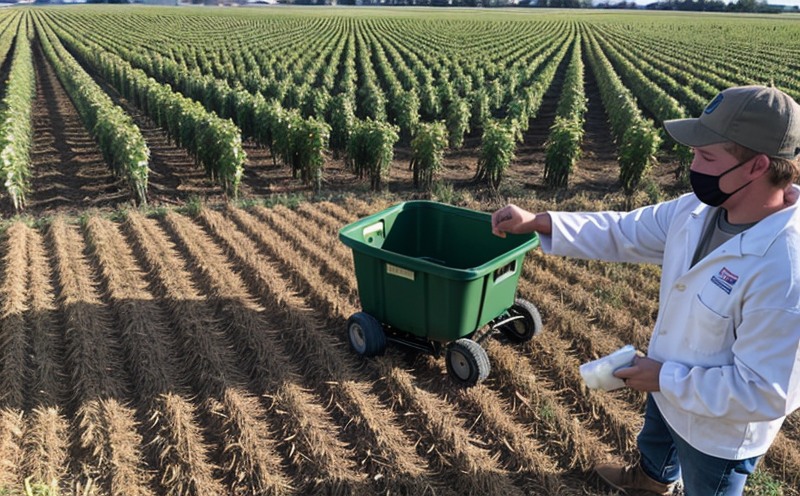Post-Harvest Quality Testing
The process of post-harvest quality testing is crucial in ensuring that agricultural products meet the highest standards before they reach the consumer. This phase involves a series of evaluations aimed at assessing the condition and quality of harvested produce, which can vary significantly depending on environmental conditions, handling practices, and storage methods. Proper post-harvest testing helps maintain product integrity and enhances marketability by identifying potential issues early.
For instance, in agriculture and forestry, fruits, vegetables, nuts, grains, and wood products undergo rigorous quality checks to ensure they are free from defects that could compromise their shelf life or consumer appeal. This includes assessing factors such as moisture content, firmness, color, and overall appearance. In the case of timber, dimensional stability is also a critical parameter.
Testing post-harvest produce involves various methods tailored to specific crop types. For fruits and vegetables, techniques like colorimetry, texture analysis, and chemical composition testing are used. These tests help determine the optimal time for harvesting and ensure that products meet quality standards set by international bodies such as ISO 13075:2008 (Colorimetric Determination of L* a* b* Values) or ASTM D143-96(2018).
Grains, on the other hand, are tested for moisture content and germination rates to prevent spoilage during storage. Wood products may be evaluated based on their dimensional stability, which is crucial for ensuring that construction materials do not warp or crack over time.
Accurate post-harvest testing is essential for maintaining food safety standards and promoting sustainable agricultural practices. By identifying defects early in the supply chain, farmers and processors can implement corrective measures to improve product quality. This not only enhances consumer satisfaction but also supports the broader goal of reducing waste throughout the agricultural sector.
Applied Standards
Post-harvest testing adheres to a variety of international standards that ensure consistency and reliability in quality assessment. Key standards include:
- ISO 13075:2008 - Colorimetric Determination of L* a* b* Values: This standard provides methods for measuring the color characteristics of agricultural products.
- ASTM D143-96(2018) - Standard Test Methods for Rubberlike Materials: While primarily used for rubber materials, this can be adapted to test the flexibility and resilience of certain wood products.
- EN 15732:2017 - Wood and Timber - Determination of Dimensional Stability in Relation to Moisture Content: This standard is specifically aimed at assessing dimensional stability in timber products, which is critical for ensuring the longevity of construction materials.
- ISO 8694-1:2015 - Grains - Methods of Sampling and Dividing: Provides guidelines for sampling grains to ensure that representative samples are used during testing.
- ASTM E739-18 - Standard Practice for Determining the Germination Potential of Seed Lots: Used to evaluate seed viability, which is essential for ensuring crop success post-harvest.
These standards provide a framework for accurate and consistent testing practices across different agricultural sectors. Compliance with these norms ensures that products meet global quality benchmarks, thereby enhancing consumer trust and marketability.
Why Choose This Test
Choosing post-harvest quality testing offers several advantages to stakeholders in the agriculture and forestry industries:
- Enhanced Product Quality: By identifying defects early, farmers can improve the overall quality of their produce, leading to higher customer satisfaction.
- Better Market Positioning: Products that meet stringent quality standards are more likely to attract premium prices and gain market recognition.
- Improved Food Safety: Ensuring that post-harvest testing is conducted according to international standards helps in maintaining food safety, reducing the risk of contamination or spoilage.
- Sustainable Practices: Post-harvest quality testing supports sustainable agricultural practices by minimizing waste and promoting efficient use of resources.
- Compliance with Regulations: Adhering to industry standards ensures that products meet regulatory requirements, thereby avoiding legal issues and sanctions.
In conclusion, post-harvest quality testing is an indispensable tool for maintaining the integrity and marketability of agricultural products. It plays a pivotal role in ensuring that consumers receive high-quality produce while also supporting sustainable practices within the industry.
Environmental and Sustainability Contributions
Post-harvest quality testing contributes significantly to environmental sustainability by promoting efficient resource utilization and minimizing waste. By identifying defects early, farmers can prevent losses that would otherwise occur during storage or transportation. This not only reduces the amount of food wasted but also decreases the carbon footprint associated with transporting spoiled products.
- Water Efficiency: Proper testing ensures that grains are dried to optimal moisture levels before storage, reducing the risk of mold and pests.
- Energy Savings: By ensuring that produce is stored at appropriate temperatures, energy consumption in refrigeration units can be minimized.
- Biodiversity Support: Sustainable agricultural practices supported by post-harvest testing contribute to preserving local ecosystems.
- Resource Conservation: Efficient use of resources such as water and energy leads to a more sustainable approach to agriculture.
In summary, post-harvest quality testing is not only beneficial for the agricultural industry but also plays a crucial role in supporting environmental sustainability. By adopting these practices, stakeholders can contribute positively to global efforts aimed at reducing waste and promoting sustainable development.





